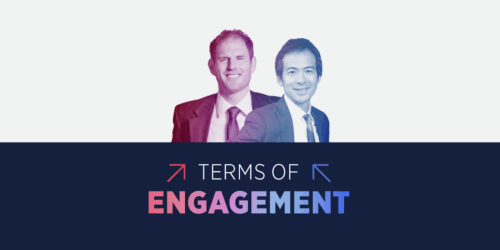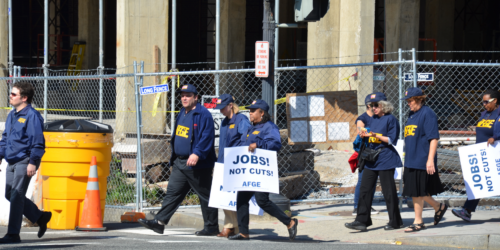In its first 100 days, the Trump administration has taken sweeping, aggressive action against federal employees, impacting hundreds of thousands of workers and sending ripple effects across the country. Still, unions have stood strong, with the AFL-CIO, AFT, AFSCME, SEIU, and others filing over a dozen lawsuits to protect workers’ rights.
To unpack these developments, the Ash Center for Democratic Governance and Innovation at Harvard Kennedy School and the Center for Labor and a Just Economy at Harvard Law School convened a panel of leading legal experts. Moderated by Harvard Law Professor Benjamin Sachs, the conversation explored the legal theory behind recent administrative changes, their practical implications for federal workers, and the legal challenges unions have mounted in response. Panelists included Craig Becker, Senior Counsel to the AFL-CIO; Seema Nanda, former U.S. Solicitor of Labor and a Fellow at the Center for Labor and a Just Economy; and Danielle Leonard, a partner at Altshuler Berzon LLP.
The New Not-Normal
Nanda began by setting the stage: “My job today is mostly to say … none of what we’re seeing — none of this is normal.” She outlined the rigorous hiring and firing processes and protections designed to ensure a functioning, nonpartisan federal workforce, including merit system protections, whistleblower safeguards, and performance improvement requirements—safeguards that most private sector workers don’t enjoy. “When you hire someone, it’s a process really geared around ensuring that the civil service is very much protected from political influence,” she added.
Against this backdrop, Becker reviewed the extraordinary disruptions seen in the administration’s first 100 days. He identified three central themes, starting with centralization of power in the president — “not simply the executive branch,” he stressed. Second, Becker highlighted the demand for “lawyer loyalty over competence or fidelity to law.” For instance, the administration replaced the head of the Office of Special Counsel with an acting official who removed restrictions on partisan political displays. “You’re going to see a lot of red hats when you walk into those federal offices,” he warned, “and if you see a blue hat, that person is going to soon be shown the door.” Third, he highlighted the use of “incivility, humiliation, and terror as tools of control,” citing USAID being publicly derided as a “left-wing money laundering scheme.”
A Toolkit for Destruction
Becker outlined five tactics used to undermine the federal workforce, starting with abrupt agency closures and deliberately confusing forced resignation offers, even for agencies created by statute. While courts have intervened, as when the National Treasury Employees Union obtained a temporary restraining order against the destruction of the Consumer Financial Protection Bureau (CFPB), the administration has often proceeded regardless, placing 80% of CFPB staff on leave despite legal rulings.
The administration has also targeted probationary employees, who lack full civil service protections and are seen as “low-hanging fruit,” in an effort to eliminate the next generation of talent. The recklessness of these firings has resulted in multiple federal court actions, injunctions, and class claims. Next, Becker described a proposed employment category called “Schedule PC,” which would reclassify around 45,000 workers as at-will employees. While not yet implemented, five lawsuits have already been filed. Finally, in what Becker called an effort “to render federal workers as defenseless as possible against this onslaught,” the administration has moved to eliminate collective bargaining rights. A March executive order excluded roughly two-thirds of federal employees from union representation, prompting another wave of litigation.
Launching Legal Resistance
Sachs then turned to Leonard, who helped lead much of the litigation Becker discussed. Her firm represents a broad coalition of labor unions, nonprofits, cities, and counties. Together, they’ve filed a comprehensive lawsuit challenging Executive Order 14210, also known as the Workforce Optimization Order, against President Trump and key federal agencies. The order requires agencies to submit reorganization and reduction-in-force (RIF) plans, viewed as a precursor to mass firings of career staff. “Make no mistake … the president gets to decide what to cut using his agents, and you have to do it,” asserted Leonard.
Leonard emphasized that the president is acting without constitutional authority “because agencies are creatures of statute.” Congress has not reauthorized presidential reorganization authority, a power it has historically granted and modified as needed. This was last used under President Carter in 1977, but it has since expired. As Sachs pointed out, the lawsuit frames the issue as one of separation of powers: the president cannot usurp Congress’ legislative role by making laws himself.
Reasons to Hope
In the face of such unprecedented attacks, there have been victories. Leonard highlighted the coalition’s case on behalf of probationary employees as an example of a legal success. The case aimed to demonstrate the range of harm being caused to employees, service recipients, and state governments. Judge William Alsup of the U.S. District Court for the Northern District of California issued a temporary restraining order, stating, “The Office of Personnel Management does not have any authority whatsoever under any statute in the history of the universe to hire and fire employees at another agency.”
However, litigation remains complex. “It’s very confusing to employees,” Leonard said. “We’ve got charts and diagrams of agencies and scope — literally, I’m looking at them right now.” Courts are addressing issues piecemeal, she added, rather than applying the Administrative Procedure Act as intended: to “hold unlawful and set aside unlawful action in its entirety.”
Becker pointed to additional wins: efforts to remove agency heads have been reversed, and many of the agency destruction cases, as in the CFPB, have been challenged successfully. In a national security exclusion case, the National Treasury Employees Union prevailed. Still, he emphasized, these legal victories are hard-won and difficult to hold onto. “The actions the administration is taking are immediate,” he said. “That’s not what the rules provide.” Whereas a typical RIF requires a 60-day notice period, here workers were abruptly placed on administrative leave. And unlike in the past, the government is now appealing temporary restraining orders, making even short-term legal wins fragile. “I think some of what we see is trying to put these things in norms that we haven’t seen tested,” added Nanda.
Yet through it all, labor has responded with resolve. Unions, nonprofits, and advocates have mobilized to defend worker rights and uphold the rule of law. That mobilization includes initiatives like Rise Up, launched to meet the legal needs of federal workers caught in this crisis. “They have no place to go,” said Becker, noting that Rise Up has already trained more than 1,500 lawyers and built the technical infrastructure to connect them with employees seeking help. Ultimately, asserted Leonard, “The coalition came together to call this what it is. It’s an unconstitutional attempt to dismantle our federal government.”


